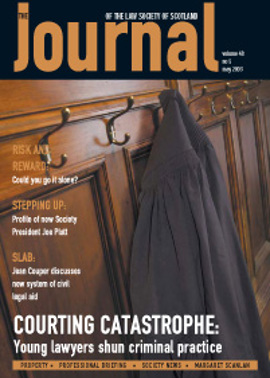Book reviews
Andrew Otterburn occupies a world where law firms have departments, partners specialise in one area of work, there are three or four fee-earners for each equity partner, and where firms have budgets for marketing and training, networked computers and time-recording systems – a world light years away from that occupied by most law firms in Scotland.
Mr Otterburn’s background is in accountancy and this book relies heavily on facts and figures. Indeed, sometimes there are too many facts and figures, obscuring the thrust of his perfectly sound arguments. There are certainly too many charts and diagrams, which tend to interrupt the reader’s flow. At one point, there are so many charts that you have to look two pages ahead to find the chart being discussed in the text.
This was never going to be an easy book. Management books are rarely light reading and you shouldn’t hold your breath while waiting for the next joke.There aren’t any.
There is, however, a bias towards larger firms, with whole chapters on Managing Partners, Senior Partners and non-lawyer managers.
What you get for your money is a densely written summary of figures-based law firm management.
The first section (dealing with financial management and how this impacts upon overall management practices) provides help towards understanding the figures in your own firm, and comparing these with other firms. There is a strong section on the measurement of profitability, although perhaps too much emphasis on the comparisons with the firms who contribute to the Scottish and English Law Societies’ surveys. It is important to remember that these surveys use only firms who choose to co-operate, which probably tends to exclude less profitable firms.
The only important comparisons are with your own figures. What is the point in worrying about not being in the top quartile for profitability, when the real problem is that your own fees haven’t risen for three years?
However, in passing, it is heart-warming to note that smaller Scottish firms appear to be more profitable than similar English firms. I suspect that this is partly because (a) we are heavily involved in Estate Agency, while they are not and (b) our insurance costs are much lower than in England.
The second section of the book correctly emphasises the importance of good management accounts; that is, a set of figures which highlight the vital matters (particularly fee income, analysed by service, department or fee-earners) and which are readable even by the majority of solicitors who suffer from “figures phobia”. My own preference is for a single sheet of figures, but, in Mr Otterburn’s world, several pages are needed for proper analysis.
If your accounts system does not produce Management Accounts or if it produces reams of unreadable print-outs, then you could benefit from the book and the excellent spreadsheets contained in the included computer disk.
The last section of the book deals with the need to have a forward strategy and a Business Plan. However, if you follow the procedures recommended for preparing your Business Plan, you will be in danger of falling into the pit marked “analysis paralysis”. Mr Otterburn reports taking up to six months (in extreme cases) simply to agree a future marketing position, before commencing to write the rest of the Plan. I suspect that such a lengthy process would prevent many firms from completing the Plan at all.
However, this is a valuable book, largely well-written and coherently argued. It is well laid-out, with useful summaries at the end of each chapter. The cost of the book is negligible compared with the value of your time in reading it and the benefits could be considerable, especially for those considering a new (or a first) approach to management accounts.
But what a difference a slightly lighter-hearted approach would have made. Is there no scope for humour in management literature?
Brian D Allingham
In this issue
- Scotland's courts face lost generation catastrophe
- Compromise is better option to confrontation
- Date set for reform package
- Risk and reward await those who go on their own
- A matter of opinion
- Organise workload to make your valuable time count
- Continuity planning takes drama out of a crisis
- Pursuers panel advises on professional negligence
- Client relations
- Platt aiming to push forward
- President's column
- Abandonment at common law still competent
- Holiday heaven or hell?
- Data Protection Act 1998 - what you need to know
- Getting to grips with debt
- Europe
- How the leopard changed its spots
- Licensing
- Scottish Solicitors' Discipline Tribunal
- Scottish Solicitors' Discipline Tribunal (1)
- Scottish Solicitors' Discipline Tribunal (2)
- Website reviews
- Book reviews
- Contaminated land must be discussed with clients
- Property reports service now online






